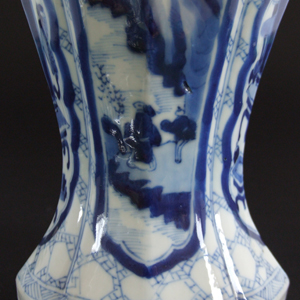
KANGXI 1662 – 1722 Chinese Export Porcelain
A Kangxi Blue and White Porcelain Vase c.1690-1710. The Compressed and Shaped Baluster Form Decorated with Four Large Panels. The Panels on the Front and Back are of Extensive Landscapes with a Building on one Side and People on the Other Side. Both Have Mountains in the Background and A River in the Mid-Ground. The Four Panels are Set Against a Cracked-Ice Ground.
SOLD
- Condition
- In very good condition but lacking it's cover. It leans very slightly and the panel with figures is very slightly dark due to firing.
- Size
- Height : 16.1 cm (10 1/2 inches)
- Provenance
- N/A
- Stock number
- 22856
Information
This Kangxi blue and white porcelain vase would have been part of a garniature or a pair of vases with covers. Vases of this type could have been used in Dutch middle class homes or as part of a mass display in a grander setting.
Baroque Displays of Kangxi Vases :
Vases such as the present examples were ordered in large quantities by the Dutch East India Company (V.O.C.) at the end of the Seventeenth Century. They were often used as part of fashionable Baroque decorative schemes, displayed on gilded brackets and on little ledges, in fact on any and every available surface. The desired effect was to show the pieces on-mass as part of a grand room setting, arranged so as to overwhelm the spectator. Garnitures were specifically made for chimney pieces but were used in many different decorative arrangements. This fashion, sometimes referred to as `China Mania` was bought from Holland to England by Mary II (Reigned 1689 -1694). Her rooms at Kensington Palace (5 Minutes Walk from our Shop) were decorated in this Fashion. Daniel Defoe (1660-1731) Stated that "The Queen (Mary) bought in the custom or humour, as I may call it, of furnishing houses with China-Ware, which increased to a strange degree afterwards, piling their China upon the tops of cabinets, scrutores, and every chymney-piece, to the top of the ceilings, and every setting up of shelves for their China-Ware, where they wanted such places, till it became a grievance in the experience of it, and even injurious to their families and estates". Even allowing for artistic licence this give an idea of the extent of the fashion.